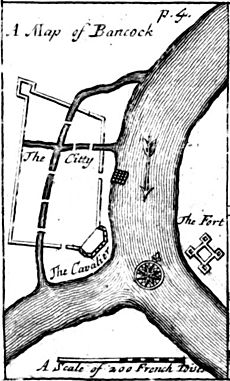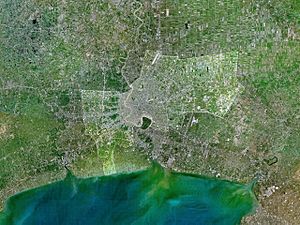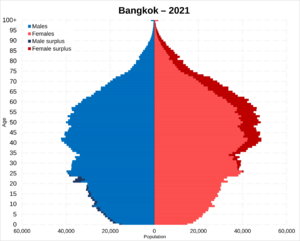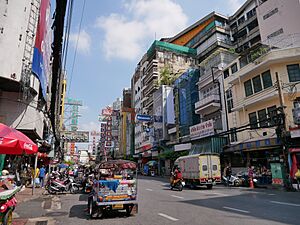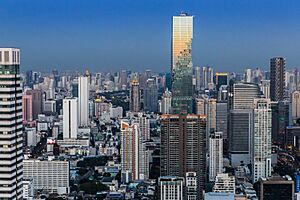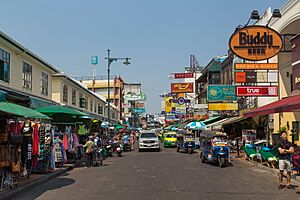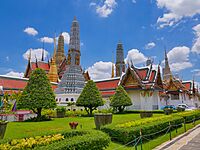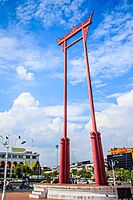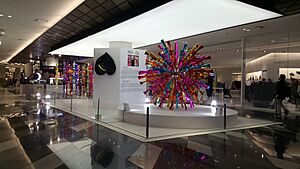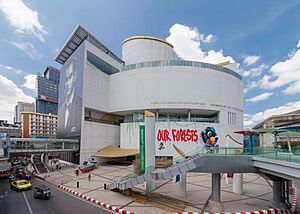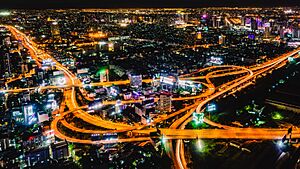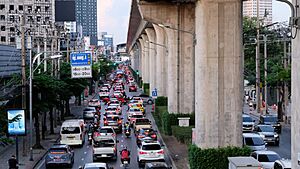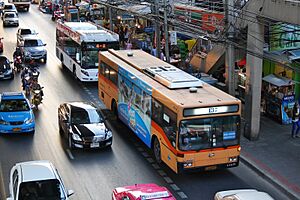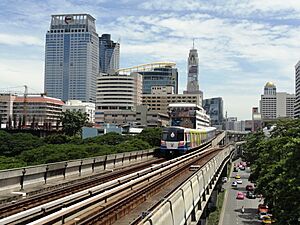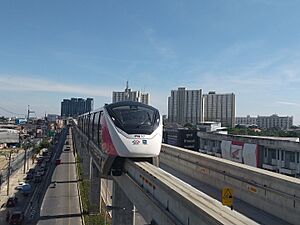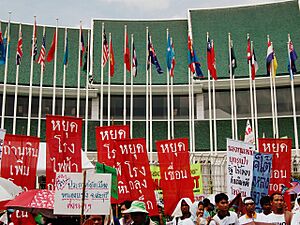Bangkok facts for kids
Quick facts for kids
Bangkok
กรุงเทพมหานคร
Krung Thep Maha Nakhon |
|||
|---|---|---|---|
|
Special administrative area
|
|||

From top, left to right: Wat Benchamabophit, Chao Phraya River skyline, Grand Palace, Giant Swing, traffic on a road in Watthana District, Democracy Monument, and Wat Arun
|
|||
|
|||
| Nickname(s):
City of Angels, The Big Mango
|
|||
| Country | Thailand | ||
| Region | Central Thailand | ||
| First settlements | c. 15th century | ||
| Founded as capital | 21 April 1782 | ||
| Re-incorporated | 13 December 1972 | ||
| Founded by | King Rama I | ||
| Governing body | Bangkok Metropolitan Administration | ||
| Government | |||
| • Type | Special administrative area | ||
| Area | |||
| • City | 1,568.737 km2 (605.693 sq mi) | ||
| • Metro | 7,761.6 km2 (2,996.8 sq mi) | ||
| Elevation | 1.5 m (4.9 ft) | ||
| Population
(2010 census)
|
|||
| • City | 8,305,218 | ||
| • Estimate
(2021)
|
9,034,000 | ||
| • Density | 5,294.2067/km2 (13,711.933/sq mi) | ||
| • Metro | 17,400,000 | ||
| • Metro density | 2,242/km2 (5,806/sq mi) | ||
| Demonym(s) | Bangkokian | ||
| GDP | |||
| • City | baht 5.747 trillion (US$ 164 billion) (2022) |
||
| • Metro | baht 8.096 trillion (US$ 232 billion) (2022) |
||
| Time zone | UTC+07:00 (ICT) | ||
| Postal code |
10###
|
||
| Area code(s) | 02 | ||
| ISO 3166 code | TH-10 | ||
Bangkok, known in Thai as Krung Thep Maha Nakhon and often just Krung Thep, is the capital and largest city of Thailand. It is located in central Thailand, on the Chao Phraya River delta. About 9 million people live in Bangkok, which is 13% of Thailand's total population. If you include the surrounding areas, over 17.4 million people live in the wider Bangkok Metropolitan Region. This makes Bangkok a huge city, much bigger and more important than any other city in Thailand.
Bangkok started as a small trading post in the 1400s during the Ayutthaya Kingdom. It grew into a capital city twice: first for the Thonburi Kingdom in 1767, and then for the Rattanakosin Kingdom in 1782. In the late 1800s, Bangkok was at the center of Thailand's efforts to modernize. The city has also been important in Thailand's political history, especially during the 1900s. It became a special administrative area in 1972.
The city grew very quickly from the 1960s to the 1980s. Today, Bangkok is a major player in Thailand's politics, economy, education, and culture. It's a big hub for travel and healthcare, and it's known for its arts, fashion, and entertainment. Bangkok is famous for its lively street life and amazing cultural sites. Places like the Grand Palace and temples such as Wat Arun and Wat Pho are popular. The city also has fun nightlife areas like Khaosan Road. Bangkok is one of the world's most visited cities by tourists.
Because Bangkok grew so fast without much planning, it has a mix of buildings and some infrastructure problems. Even with a large network of highways, traffic jams are a big issue because there are too many cars. This also caused a lot of air pollution in the 1990s. The city is now trying to fix this by building more public transport, like train lines.
Contents
History of Bangkok
Bangkok's story began in the early 1400s as a small village. It was on the west side of the Chao Phraya River, ruled by the Ayutthaya Kingdom. Its location near the river's mouth made it important for trade. It became a customs checkpoint with forts. In 1688, there was a siege where the French were forced out of Siam.
After Ayutthaya fell to the Burmese in 1767, King Taksin made Bangkok his capital. This started the Thonburi Kingdom. In 1782, King Phutthayotfa Chulalok (also known as Rama I) became king. He moved the capital to the eastern side of the river, to Rattanakosin Island. This marked the beginning of the Rattanakosin Kingdom. The city's founding date as the capital is considered to be April 21, 1782.
How Bangkok Grew and Changed
Bangkok's economy grew through trade with China and later with Western countries in the 1800s. As the capital, Bangkok was key to Siam's modernization. This happened as Western powers put pressure on the country in the late 1800s. Kings Mongkut (Rama IV, 1851–68) and Chulalongkorn (Rama V, 1868–1910) brought in new technologies. These included steam engines, printing presses, railways, and public services like education and healthcare.
Bangkok became the main stage for political changes in Thailand. This included the time when the country stopped having an absolute monarchy in 1932. During World War II, Bangkok was bombed because Thailand allied with Japan. However, the city grew very fast after the war. This was helped by aid from the US and government investments. Bangkok's role as a place for US military personnel to relax also boosted its tourism.
Modern Bangkok's Development
Rapid growth led to more people moving from rural areas to Bangkok. The city's population jumped from 1.8 million to 3 million in the 1960s. After the US left Vietnam in 1973, Japanese businesses invested a lot. This led to more manufacturing and growth in Bangkok's financial market. The city continued to grow quickly through the 1980s and early 1990s. This growth slowed down during the 1997 Asian financial crisis.
By then, many problems had appeared, like the city's famous traffic jams. Bangkok remains a center for protests and political events. The city's administration was officially set up in 1906. In its current form, Bangkok was created in 1972. This happened when two provinces, Phra Nakhon and Thonburi, merged.
What's in a Name?
The name Bangkok comes from the Thai word Bang (บาง). This means 'a village on a stream'. The full official Thai name is very long:
Krungthepmahanakhon Amonrattanakosin Mahintharayutthaya Mahadilokphop Noppharatratchathaniburirom Udomratchaniwetmahasathan Amonphimanawatansathit Sakkathattiyawitsanukamprasit
กรุงเทพมหานคร อมรรัตนโกสินทร์ มหินทรายุธยา มหาดิลกภพ นพรัตนราชธานีบูรีรมย์ อุดมราชนิเวศน์มหาสถาน อมรพิมานอวตารสถิต สักกะทัตติยวิษณุกรรมประสิทธิ์
This long name means:
City of angels, great city of immortals, magnificent city of the nine gems, seat of the king, city of royal palaces, home of gods incarnate, erected by Vishvakarman at Indra's behest.
It is listed in Guinness World Records as the world's longest place name. Many Thais know this name because of a popular 1989 song. Today, the city is officially called Krung Thep Maha Nakhon in Thai. People often shorten this to Krung Thep. This name means 'City of Angels'. Another fun nickname for Bangkok is The Big Mango.
How Bangkok is Governed

Bangkok is run by the Bangkok Metropolitan Administration (BMA). It's a special administrative area, different from other provinces in Thailand. The city's leader, called the Governor, is chosen by direct election every four years. The Governor and four deputies manage the city's policies.
Bangkok is divided into fifty districts. These districts are like smaller towns within the city. Each district has a director chosen by the Governor. There are also district councils that advise these directors.
The BMA handles many important city services. These include city planning, building rules, transportation, and waste management. They also oversee education, medical care, and rescue services. The city's official symbol shows the Hindu god Indra riding his divine white elephant, Airavata. The city's tree is the Ficus benjamina.
As the capital, Bangkok is where the national government is located. The Government House, Parliament House, and the highest courts are all here. The Grand Palace and Dusit Palace are the official homes of the king. Most government ministries also have their main offices in Bangkok.
Bangkok's Geography
Bangkok covers an area of about 1,568 square kilometers. It is located in the flat Chao Phraya River delta. The river flows through the city and into the Gulf of Thailand. The city is very low-lying, with an average height of only 1.5 meters above sea level. Much of the area was originally swampland.
Waterways and Flooding
Over centuries, many canals (called khlong) were built to drain the land and help with farming. These canals also served as the main way to travel until modern roads were built in the late 1800s. Because so many people lived near or on the water, Bangkok was once called the "Venice of the East." Many canals have since been filled in, but some still exist for drainage and transport. Sadly, many are now polluted.
The ground in Bangkok is made of soft clay. This, along with too much groundwater pumping, has caused the city to slowly sink. This sinking makes Bangkok more likely to flood. The city already faces floods due to its low elevation and poor drainage. Heavy rains and water from upstream areas often cause flooding. Major floods happened in 1995 and 2011.

Because it's on the coast, Bangkok is also at risk from rising sea levels due to global warming. Some studies suggest that parts of the city could be underwater by 2030. There are no mountains in Bangkok. The only hill, Phu Khao Thong, was actually built from a collapsed temple structure.
Bangkok's Climate
Bangkok has a tropical savanna climate. This means it's hot all year round. Temperatures usually range from 23.2°C in December to 35.7°C in April. The average yearly temperature is 28.9°C.
The city has three seasons: hot, rainy, and cool. The rainy season starts in mid-May with the southwest monsoon. September is usually the wettest month. The dry and cool season lasts from October to February. The hot season is generally dry, but sometimes has summer storms.
Scientists predict that Bangkok will experience more days with very high temperatures due to climate change.
Districts of Bangkok
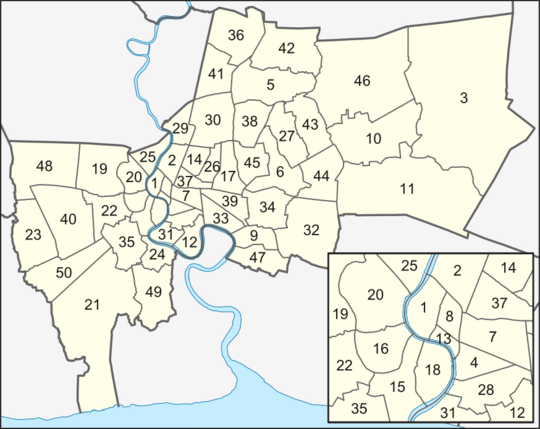
Bangkok is divided into fifty districts. These are like local government areas. Thirty-five districts are on the east side of the Chao Phraya River. Fifteen are on the western side, known as the Thonburi side. Each district is further divided into smaller areas called sub-districts.
City Layout and Neighborhoods
Bangkok's city layout is quite mixed. It grew quickly without strict planning. This means you'll see a blend of old and new buildings. The city has expanded outwards, with suburbs stretching into nearby provinces. However, there are still large farming areas on the eastern and western edges.
The historic heart of Bangkok is Rattanakosin Island. This is where you'll find the Grand Palace and important Buddhist temples. These include Wat Phra Kaew and Wat Pho. This area also has many traditional neighborhoods and markets. One famous spot is Sampheng, the Chinese settlement.
In contrast, areas like Si Lom and Sathon are full of skyscrapers. These are major business districts. The Siam and Ratchaprasong areas are known for their huge shopping malls. Many hotels and shops also line Sukhumvit Road.
Bangkok doesn't have just one main business center. Instead, areas like Siam and Ratchaprasong act as a "central shopping district." The Victory Monument is a very important road junction. It serves over 100 bus lines and has an elevated train station.
Many of Bangkok's streets have traditional shophouses. But the city has also seen a boom in skyscrapers since the 1980s. Bangkok was ranked as the world's eighth tallest city in 2016. Sadly, due to economic differences, many informal settlements exist. In 2000, over a million people lived in about 800 such areas.
Parks and Green Spaces
Bangkok has several parks, but the amount of park space per person is quite small. The city aims to increase green spaces. One of the largest parks is Lumphini Park, located near the business district. It's connected to Benjakitti Park by a walkway.
Other notable parks include Suanluang Rama IX in the east and the Chatuchak–Queen Sirikit–Wachirabenchathat park complex in northern Bangkok. The Green Bangkok 2030 project plans to add more green spaces and tree cover to the city.
People of Bangkok
In 2010, Bangkok had a population of over 8.3 million people. By 2020, estimates put the number at over 10.5 million. Many people living in Bangkok have moved from other parts of Thailand. Bangkok is a very diverse city. It is home to many people from other countries, including China, Japan, Europe, and neighboring countries like Myanmar and Cambodia.
Bangkok's population grew slowly at first. But in the late 1800s, as the city modernized, more people moved there. This growth sped up in the 1930s. By the 1980s, Bangkok was much larger than any other city in Thailand.
Most people in Bangkok are Thai. Historically, Chinese immigrants made up a large part of the city's population. Today, Bangkok still has a big Chinese community, especially in Yaowarat, which is Bangkok's Chinatown.
Most people in Bangkok (93%) are Buddhist. Other religions include Islam (4.6%) and Christianity (1.9%). Besides Yaowarat, Bangkok has other unique neighborhoods. The Indian community is centered in Phahurat. There are also communities of Cham people and a Muslim community near Haroon Mosque. Newer communities of Japanese and Arab people can be found along Sukhumvit Road.
Bangkok's Economy
Bangkok is the main economic hub of Thailand. In 2022, the city's economy produced about 5.7 trillion baht (which is about US$164 billion). This means the average person in Bangkok earns more than twice the national average.
The biggest part of Bangkok's economy is wholesale and retail trade. This makes up 24% of the city's total economic output. Manufacturing, real estate, and financial services are also very important. Bangkok handles almost half of Thailand's service sector. When you look at the wider Bangkok area, manufacturing is the biggest contributor. This is because many factories are located in the nearby provinces. Tourism also brings in a lot of money for Bangkok.
The Stock Exchange of Thailand (SET) is located in Bangkok. Many international companies have their regional headquarters here. This is because the cost of labor and operations can be lower than in other big Asian cities. Bangkok is considered an important "world city" for finance and business.
However, there is a big difference in income between people in Bangkok. There are many lower-income workers from rural areas and neighboring countries. Then there are middle-class professionals and wealthy business owners. While very few people in Bangkok live in extreme poverty, the gap between rich and poor is still quite large.
Tourism in Bangkok

Bangkok is one of the most popular places for tourists in the world. In 2017, it was ranked as the top city for international visitors, with over 20 million people visiting. It has also been named the "World's Best City" by Travel + Leisure magazine for several years.
Most international tourists arriving in Thailand visit Bangkok first. Many Thai people also travel to Bangkok for holidays. In 2010, over 26 million Thai visitors and 11 million foreign visitors came to the city.
Popular Tourist Sights
Some of Bangkok's most famous sights include the Grand Palace and important Buddhist temples. These are Wat Phra Kaew, Wat Pho, and Wat Arun. The Giant Swing and Erawan Shrine show the influence of Hinduism in Thai culture. Vimanmek Mansion is known as the world's largest teak building. The Jim Thompson House shows traditional Thai architecture.
You can also take boat trips on the Chao Phraya River and canals. These trips offer views of old buildings and traditional ways of life along the water.
For shopping, Bangkok has huge malls in Siam and Ratchaprasong. The Chatuchak Weekend Market is also very popular. The Taling Chan Floating Market is one of the few floating markets left in Bangkok. Yaowarat (Chinatown) is famous for its shops and street food. Khao San Road is well-known among backpackers for its affordable places to stay, shops, and bars.
Sometimes, tourists might face issues like scams or being overcharged. One common scam involves tricking tourists into buying overpriced jewelry.
Culture in Bangkok
Bangkok's culture shows its role as Thailand's center for wealth and modern ideas. Western ideas and goods have been mixed with Thai traditions. This is especially clear in the lives of the growing middle class. Shopping centers are popular places to hang out on weekends.
Image:Puy the Roti Lady Benjawan Kaewsaen and her sister Palm in Saladang Bangkok Thailand by Don Ramey Logan.jpg A unique part of Bangkok is the many street vendors. They sell everything from food to clothes. Many people in the city rely on these vendors for their meals. The city government has tried to control the number of street vendors. This is to clear up sidewalks and public spaces. However, some worry that these changes might take away from the city's special character.
Festivals and Events
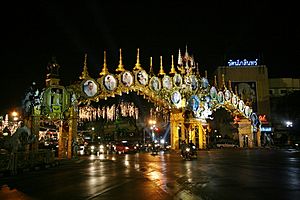
Bangkok residents celebrate many of Thailand's yearly festivals. During Songkran (April 13–15), people enjoy traditional rituals and fun water fights. Loi Krathong, usually in November, involves floating decorated baskets on water. New Year celebrations happen in many places, especially at CentralWorld.
Events related to the royal family are mainly held in Bangkok. For example, on King Chulalongkorn Memorial Day (October 23), wreaths are placed at his statue. The birthdays of the previous king and queen are national holidays. They are celebrated with speeches and public gatherings.
Sanam Luang hosts the Thai Kite, Sport and Music Festival. The Red Cross Fair in April offers goods, games, and exhibits. The Chinese New Year and Vegetarian Festival are widely celebrated by the Chinese community in Yaowarat. Bangkok was named the World Book Capital in 2013 by UNESCO. The city also hosts Pride Parades, with the first official "Bangkok Naruemit Pride Parade" held in 2022.
Media in Bangkok
Bangkok is the center of Thailand's media industry. All national newspapers, TV and radio stations, and major publishers are based here. Newspapers like Thai Rath and Daily News print millions of copies daily. There are also English newspapers like the Bangkok Post. Most of Thailand's magazines are published in Bangkok.
All six national TV channels have their main studios in the capital. Most TV shows are made in Bangkok and then shown across the country. Cable TV is also growing, with many channels based in Bangkok. Bangkok has many cinemas and hosts two major film festivals each year.
Art and Performance
Traditional Thai art is supported by government groups in Bangkok. Many communities still practice traditional crafts, like making khon masks. The National Gallery displays both traditional and modern art.
Bangkok's contemporary art scene has grown a lot. Private galleries help new artists show their work. The Bangkok Art and Culture Centre is the city's largest public art space. There are also many other art galleries and museums.
The city's performing arts include traditional Thai theater and dance, as well as Western plays. Khon and other traditional dances are performed at the National Theatre. The Thailand Cultural Centre hosts musicals, orchestras, and other events.
Sports in Bangkok
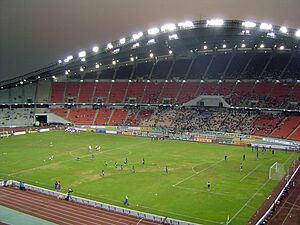
In Bangkok, association football (soccer) and Muay Thai (Thai boxing) are the most popular spectator sports. Several major football clubs are based in the Bangkok area. The Rajadamnern and Lumpini stadiums are the main places to watch kickboxing.
While sepak takraw (a sport played with a woven ball) is seen in open spaces, modern sports are now common. Golf is popular among wealthier people. Horse racing still takes place at the Royal Bangkok Sports Club.
Bangkok has many public sporting facilities. The main ones are the National Stadium complex and the newer Hua Mak Sports Complex. Bangkok has hosted the Asian Games four times, more than any other city. It also hosted the first Southeast Asian Games in 1959.
Getting Around Bangkok
Historically, Bangkok's canals were important for transport. But now, land transport is much more common. The first modern road, Charoen Krung Road, was built in 1864. Since then, the road network has grown a lot. A complex system of elevated highways helps traffic move. However, Bangkok's fast growth has caused big traffic jams since the 1990s.
Even though trains were introduced in 1893, Bangkok's first modern rapid transit system only started in 1999. Older public transport includes a large bus network and boat services on the Chao Phraya River and canals. Taxis are available as cars, motorcycles, and "tuk-tuk" auto rickshaws.
Roads and Traffic
Roads are the main way people travel in Bangkok. The city's streets don't follow a simple grid pattern. Forty-eight major roads connect different areas. These roads branch into smaller streets and lanes called soi. Eleven bridges cross the Chao Phraya River, connecting the two sides of the city.
The rapid growth in the 1980s led to many more vehicles. In 2006, there were almost 4 million vehicles in Bangkok. This caused severe traffic jams. The city has tried to fix this by building more elevated highways and new train systems. But traffic remains a big problem.
Traffic has also been the main cause of air pollution in Bangkok. Levels were very high in the 1990s. Efforts to improve fuel quality helped reduce pollution. However, with more vehicles, pollution is still a concern.
Cycling is not very practical in Bangkok, especially in the city center. Many bike lanes share space with pedestrians. Poor maintenance and street vendors can block these paths.
Buses and Taxis
Bangkok has a large bus network. The Bangkok Mass Transit Authority (BMTA) runs most bus services. There are also private operators. A special bus rapid transit (BRT) system has been running since 2010. Long-distance buses connect Bangkok to all other provinces.
Taxis are very common in Bangkok. There are over 100,000 car taxis, 58,000 motorcycle taxis, and 8,996 tuk-tuk tricycles. Car taxis must use meters. Tuk-tuk fares are usually agreed upon before the ride. Motorcycle taxis are good for short trips.
Some ride-hailing apps like Grab and AirAsia also operate in the city. MuvMi is a startup that offers electric tuk-tuk services in some areas.
Train Systems
Krung Thep Aphiwat Central Terminal is the new main train station for national rail services. The older station, Bangkok (Hua Lamphong) Railway Station, is still used for commuter trains.
Bangkok has four rapid transit systems:
- The BTS Skytrain (elevated trains)
- The MRT (underground metro and monorails)
- The SRT Red Lines (commuter rail)
- The Airport Rail Link (connects to the airport)
The BTS started in 1999, and the MRT in 2004. These systems have become very important for daily commuters. The city is still building more train lines to expand the network.
Water Transport
Water transport is less common now but still important. Several water buses serve commuters daily. The Chao Phraya Express Boat stops at many places along the river. The Khlong Saen Saep boat service runs on a canal. Long-tail boats also operate on the Chao Phraya. Passenger ferries cross the river at many points.
Khlong Toei Port was Thailand's main international port for many years. It is now mostly a cargo port.
Airports

Bangkok is one of Asia's busiest air travel hubs. The city has two commercial airports:
- Suvarnabhumi Airport (the main international airport)
- Don Mueang International Airport (older airport, now mainly for domestic and low-cost international flights)
Suvarnabhumi Airport is very busy, serving over 52 million passengers in 2015. It is currently being expanded to handle even more passengers.
Bangkok's International Connections
Bangkok works with other major cities around the world through "sister city" agreements. It also joins international organizations and networks.
Global Role
Because of its location in Southeast Asia, Bangkok is home to many international organizations. These include offices for the United Nations (UN) like ESCAP, FAO, ILO, UNHCR, and UNICEF.
Sister Cities
Bangkok has made friendship agreements with many cities and regions around the world. These include:
- Aichi Prefecture, Japan (2012)
- Ankara, Turkey (2012)
- Astana, Kazakhstan (2004)
- Beijing, China (1993)
- Brisbane, Australia (1997)
- Budapest, Hungary (1997)
- Busan, South Korea (2011)
- Chaozhou, China (2005)
- Chengdu, China (2017)
- Chongqing, China (2011)
- Daegu, South Korea (2017)
- Dalian, China (2016)
- Fukuoka Prefecture, Japan (2006)
- George Town, Malaysia (2012)
- Guangzhou, China (2009)
- Hanoi, Vietnam (2004)
- Ho Chi Minh City, Vietnam (2015)
- Huế, Vietnam (2016)
- Jakarta, Indonesia (2002)
- Lausanne, Switzerland (2009)
- Lisbon, Portugal (2016)
- Manila, Philippines (1997)
- Moscow, Russia (1997)
- Porto, Portugal (2016)
- Phnom Penh, Cambodia (2013)
- Saint Petersburg, Russia (1997)
- Seoul, South Korea (2006)
- Shandong, China (2013)
- Shanghai, China (2012)
- Shenzhen, China (2015)
- Tehran, Iran (2012)
- Tianjin, China (2012)
- Ulaanbaatar, Mongolia (2017)
- Vientiane, Laos (2004)
- Washington, D.C., United States (1962, 2002)
- Wuhan, China (2013)
See also
 In Spanish: Bangkok para niños
In Spanish: Bangkok para niños




